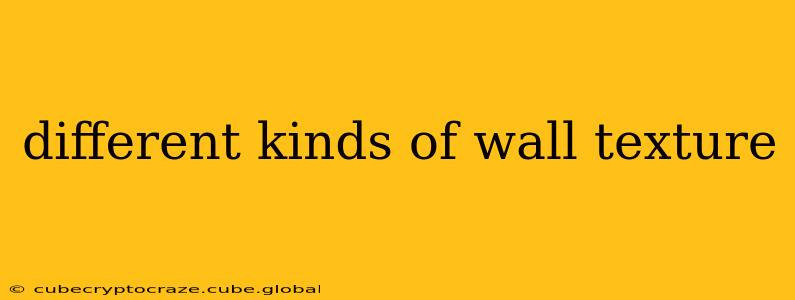Adding texture to your walls transforms a space from bland to breathtaking. It can add depth, visual interest, and even influence the overall mood of a room. From subtle to dramatic, the options are vast and varied. This guide explores the different kinds of wall textures, helping you choose the perfect one for your project.
What are the most popular wall texture types?
The most popular wall texture types broadly fall into categories based on the application method and the resulting visual effect. These include:
-
Smooth: This classic choice provides a clean, minimalist look. It's perfect for modern or contemporary spaces and offers a great base for paint colors to truly shine.
-
Rough: Rough textures create a rustic, more tactile feel. They often add a sense of warmth and character to a room. Think exposed brick or heavily textured plaster.
-
Patterned: Patterned textures involve creating a repeating design on the wall, often using techniques like stenciling or stamping. This can add a significant design element to your space.
What are the different types of wall texture finishes?
Beyond the broad categories, let's dive deeper into specific types of wall texture finishes:
1. Plaster Textures:
Plaster offers incredible versatility. Different techniques yield vastly different results:
-
Venetian Plaster: This luxurious finish creates a smooth, almost marble-like appearance. It's known for its elegant, sophisticated look and is often used in high-end interiors.
-
Sand Finish Plaster: This creates a slightly rough, sandy texture, providing a subtle visual interest without being overly dramatic.
-
Knockdown Texture: A popular choice for its versatility, knockdown texture involves applying a thick layer of plaster and then "knocking down" the peaks with a tool, creating a slightly bumpy, irregular surface.
-
Skip Trowel Texture: This technique involves applying plaster with a trowel in a specific pattern, resulting in a more pronounced, textured surface with visible trowel marks.
2. Paint Textures:
Paint itself can be used to create texture:
-
Rag Rolling: Using a crumpled rag to apply paint creates a unique, mottled effect.
-
Sponge Painting: A sponge can be used to dab paint onto the wall, yielding a slightly more textured, uneven finish.
-
Stippling: This technique involves using a stippling brush or similar tool to create a dotted or speckled effect on the wall.
-
Textured Paint: Many paints are specifically formulated to add texture. These often come pre-mixed with additives that create a raised surface.
3. Wallpaper Textures:
Wallpaper opens up a world of textural possibilities:
-
Grasscloth: This natural fiber wallpaper offers a subtle, organic texture.
-
Fabric-Covered Wallpaper: Wallpaper mimicking fabrics like linen or velvet adds a luxurious, soft touch.
-
Embossed Wallpaper: Embossing creates raised patterns on the wallpaper, adding significant depth and visual interest.
4. Other Textured Wall Finishes:
Beyond plaster, paint, and wallpaper, other options include:
-
Exposed Brick: This classic choice adds rustic charm and warmth.
-
Wood Paneling: Wood paneling provides a natural, warm texture and can be used in various styles.
-
Stone Veneer: This offers a luxurious, natural stone look without the high cost and weight of real stone.
How do I choose the right wall texture for my home?
Choosing the right wall texture depends heavily on your personal style and the overall aesthetic of your space. Consider these factors:
-
Room size: Highly textured walls can make a small room feel smaller. In smaller spaces, opt for subtle textures.
-
Lighting: Texture interacts with light, affecting how a room feels. Rough textures can absorb more light, while smooth ones reflect it.
-
Style: Different textures suit different design styles. A rustic space might benefit from rough textures, while a modern space might prefer smooth ones.
-
Maintenance: Some textures are easier to clean and maintain than others.
What are some popular wall texture ideas?
Popular wall texture ideas include:
-
Accent Walls: Use texture to create a focal point in a room.
-
Textured Ceilings: Extend the textural treatment to your ceiling for a more cohesive look.
-
Combination Textures: Use a combination of textures for a visually striking effect.
By carefully considering your options, you can choose wall textures that enhance your home’s beauty and create a truly personalized space. Remember to explore samples and experiment to find the perfect fit for your vision.
